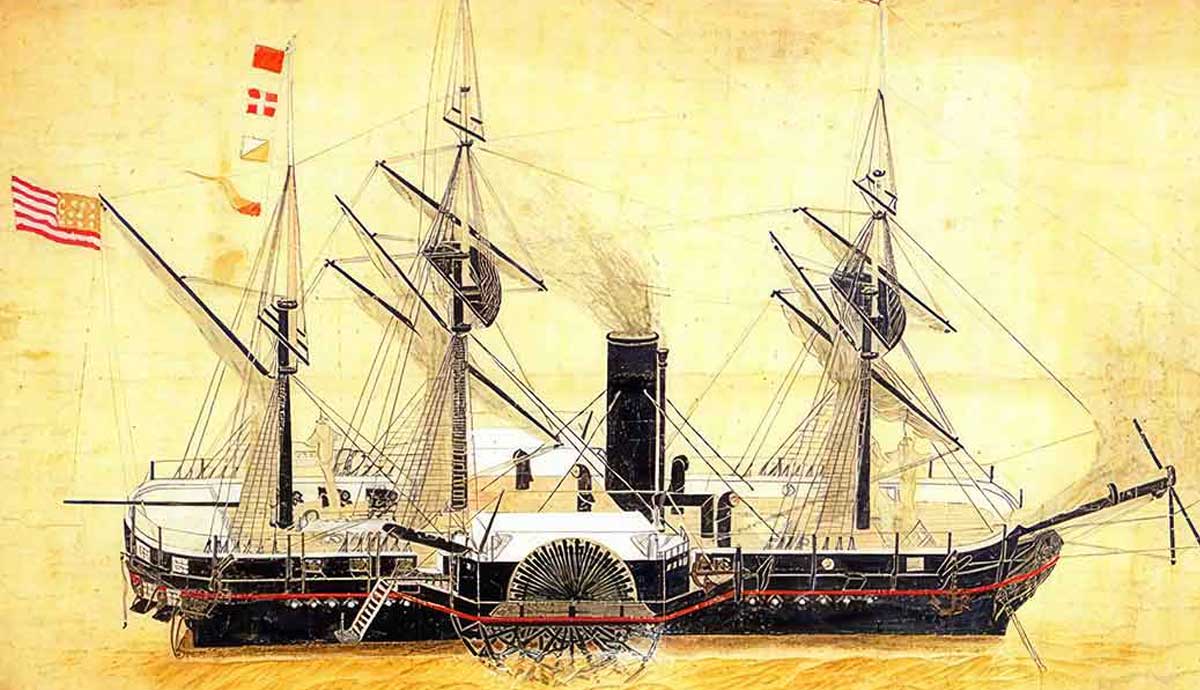How American Black Ships Changed Japan Forever
Perrys flagship Powhatan. Source: Peabody Essex MuseumFor over two centuries after 1600, Japan existed as an enigma wrapped in a mystery, refusing nearly all interactions with the rest of the world. The mid-nineteenth century altered that world entirely as American ships, painted black, sailed into Tokyo Bay.IsolationEuropeans in Japan. Source: Wikimedia CommonsJapans involvement with Western countries started with Portuguese ships landing in 1543. Within a short time, Europeans came to Japan. In return, Japanese traders went to parts of Asia or the Philippines. The cultural influence traveled both ways, often to mutual benefit. By 1600, the attitude of the Japanese Bakufu, or government under the Japanese Emperor, had shifted completely.The Bakufu saw Western influences and unfair trading practices as a threat. For example, Jesuit priests converted thousands of Japanese to Catholicism, replacing the emperor as a deity. Fearing that, plus political instability, the Bakufu under the Shogun expelled most foreigners. The Dutch, Koreans, and Chinese maintained a legal but extremely restricted status. By 1630, Japan had become a mystery, reacting fiercely to any intrusions for two hundred years.Tokugawa EraTokugawa Ieyasu, by Kano Tan Yu, early Edo Period. Source: Wikimedia CommonsDespite closing itself off, the Tokugawa Era sprouted into one of prosperity, economic growth, and stability. The samurai, peasant, and noble society grew into a stable, stiff hierarchy with the emperor at the top. The economys complexity quickly matched anything developed in the West.The Black ShipsOne of Perrys steam-driven Black Ships. Detail from British Library manuscriptTo Japans shock, on July 8, 1853, four black-painted ships entered Tokyo Bay, sailing against the tide. These ships, under the command of American Commodore Matthew Perry, came with the expressed mission of opening Japan to the West, especially the United States. The missions goals included coal stations for American ships, proper treatment of American sailors, and opening Japans ports to trade.The Japan Expedition wanted to establish America as a power in Asia, and Japans ideal location met that goal. Perrys four ships were immediately swarmed by Japanese guard boats ordering the Americans to depart. However, Perry refused, stating he carried a letter for Japans emperor; this could only be delivered to him, and Perry would carry out his mission by force if needed.Shogun in Audience. Source: Los Angeles County Museum of ArtThe Bakufu in Edo waivered but ultimately relented after discussions between the local leaders and the Shoguns Council of Ministers in Edo (now Tokyo). The Bakufu knew their weapons to be inferior to those that Perrys ships carried. Two local leaders accepted the American letter, hoping to end this embarrassing visit, but Perry said he would return next year to establish diplomatic relations. Perrys first visit caused a crisis. Some nobles, or daimyo, wanted to resist, while others advocated a measured reply. All knew that Perrys Black Squadron would be back. The first crack had just appeared.The Return and More ProblemsThe Treaty of Kanagawa Signing 1854. Source: Library of CongressThe American fleet returned on February 13, 1854, with nine ships looking to negotiate. The fleet arrogantly moved further up Tokyo Bay. The Tokugawa Bakufu had strengthened defenses around Tokyo Bay in case of clashes.After weeks of stalling, counter demands, and threats of force, Japan signed the Treaty of Kanagawa on March 13, 1854, meeting all American demands. Besides trading rights, two Japanese ports were opened to American ships and traders: Shimoda and Hakodate. Perry succeeded in his mission, but the Treaty gave Japan a number of problems.First, many daimyo resented foreigners living in Japan. Others chafed under Tokugawa rule and saw the Bakufus American dealings as a weakness. They feared Japans fate would be carved up like Chinas. The Bakufu got criticized overtly. Over the next several years, the Russians, French, and British demanded and got similar trading concessions, further weakening the Shoguns hold on the country.Pressure and Imperial ResponseEmperor Meiji. Source: Mainichi ShinbunThe strain on the Bakufu became worse as the 1850s closed out. Opposition to any foreign treaties grew with the nobles. The daimyo remained nationalistic, still calling for the expulsion of the Westerners. Each time the Shogun tried to bargain with the daimyo, they grew weaker in their opponents view. Walking the line between Treaty obligations and mollifying their opponents proved difficult.Even the Imperial Court sensed the Bakufu weakening as it opposed any Shogun candidates, something that had not been performed in centuries. In 1859 the Bakufu signed a new treaty, though opposed by the emperor, allowing significant concessions, like unrestricted trading and extraterritoriality. Clashes broke out in 1865 following Emperor Osahitos death between nationalists and the Bakufu. The nationalists, loyal to the new Emperor Meiji, fought hard. By 1867, the Bakufu had given up restoring all of the rule to the emperor. The Black Ships under Perry came when the Shogun and Bakufus control weakened. Unable to respond to pressure on both sides, the Bakufu collapsed; Japans rapid modernization would soon begin.


